The Lar Lubovitch Dance Company Celebrates its 50th Anniversary Season
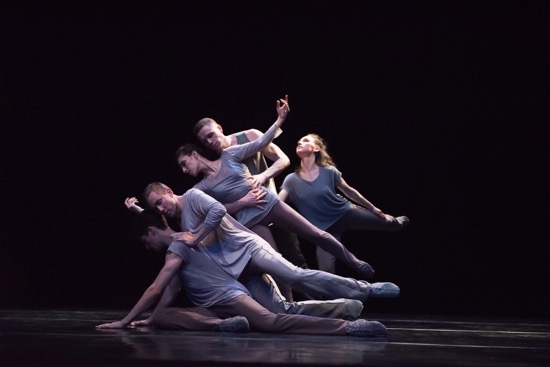
Lar Lubovitch’s Something About Night. (L to R): Barton Cowperthwaite, Brett Perry, Nicole Marie Corea, Tobin Del Cuore, and Belinda McGuire. Photo: Nan Melville
Once upon a time, most modern dance choreographers created companies named after them and starred in their own works. In 1958, Alvin Ailey was an exception. The José Limón Company and the Martha Graham Dance Company became repertory companies after the death of their founder. In recent years, Paul Taylor and later Stephen Petronio—very much alive and creative—have either commissioned new works by others for their companies or remounted iconic ones. Kyle Abraham’s company, A.I.M, will perform works by three other choreographers during its May season at the Joyce Theater. Because of this collegial climate, I saw Lar Lubovitch’s Legend of Ten twice in two weeks: first during the Graham company’s season at City Center, then performed a week later by the Graham dancers during the Lar Lubovitch Dance Company’s 50th (!) anniversary season at the Joyce. Honoring one’s heritage and being inclusive could be powerful urges in these troubled times.
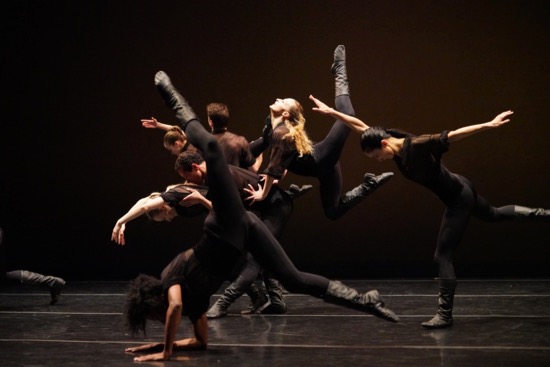
The Martha Graham Dance Company in Lar Lubovitch’s The Legend of Ten. Photo: Justin Chao
I enjoyed seeing Legend of Ten (2010) in the Joyce’s intimate performance space more than I did in the capacious City Center, in part because I could focus more intently on the individuality of the ten Graham dancers, but also because they now seemed more at home in the ongoing, shifting flow of the piece. Being at home in this case means following their paths through the gorgeous rivers and streams of Johannes Brahms’s Quintet for Piano and Strings in F minor (movements I and IV only) without losing intent or focus. This time the central couple’s roles were performed beautifully and expressively by Anne O’Donnell and Lloyd Mayor. (for more on the Graham Company’s performance during its own season: https://www.artsjournal.com/dancebeat/2018/04/martha-graham-sacred-and-profane/
Lubovitch’s new work, Something about Night, is also set to music by a major 19th-century composer: Franz Schubert. Four of his songs for male chorus (as recorded by the Wiener Volkalisten and conducted by Robert Shaw) create a sweet, occasionally troubled ambiance. The cast is small: Brett Perry, Nicole Marie Corea, Tobin Del Cuore, Belinda McGuire, and Barton Cowperthwaite. They wear becoming practice clothes by Reid Bartelme & Harriet Jung, and Clifton Taylor keeps the lights mysteriously nocturnal.
In this, as in the other two pieces on the season’s Progam A, you can become familiar—maybe enthralled—by the most memorable aspects of Lubovitch’s style. One is the rise-suspend-sink quality, as if he were making visible the pattern of ecstatic or hopeful breathing. When the dancers crest and plunge, you might also think of ocean waves repeatedly arching to break on the beach. He’s also gifted at designing clusters in which intimacy becomes a liquid but intricate interchange of pull and push, rise and fall, lift and set down, connect and separate. Your eyes probe both what individuals are doing and the ways in which tensions and urges shape the look of the whole group.
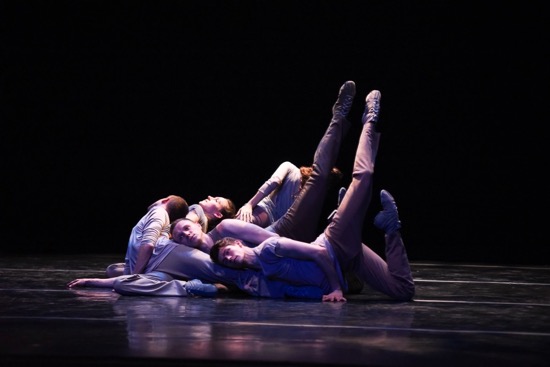
The beginning of Lar Lubovitch’s Something About Night. Photo: Nan Melville
They dancers begin coiled together in the center of the stage. Like sleepers beginning to stir, they rise and sink in small, shifting ways, gradually building to raising their legs into the air, and eventually to standing. Perry performs a solo marvelously, bringing out the small accents and twists with which Lubovitch studs the ongoing flow. Corea and Del Cuore are partnered, then McGuire and Cowperthwaite. Lubovitch has said that Something About Night consists of woven-together fragments of many dances drawn from his 50-year history. Even before I read those words, the performers’ unstressed encounters seemed to me like bits of driftwood floating to the surface of waves, eddies, and small whirlpools. But his fine dancers are also responding to the landscape of Schubert’s songs about night and love, to the low murmur of men’s voices, to the sudden high tenor calling out.
Sometimes watching pieces by Lubovitch, such as this one, I find myself getting lost in his created worlds. They’re so rich, so fluid that the dancers often seem to be without motive. Marvelously controlled though they are, they give the impression of being at the mercy of waves or winds or their submerged passions, while also taking sensuous pleasure in the movement. Duets occasionally involve one person manipulating another, but mostly convey mutually pleasurable tangles and the pressure of body against body.
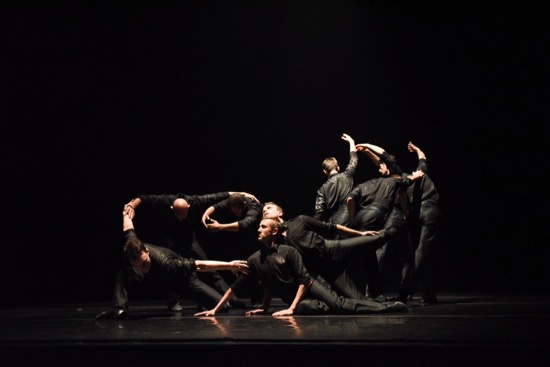
Lar Lubovitch’s Men’s Stories. Photo: Nan Melville
Maybe the fact that I consider Lubovitch’s Men’s Stories (subtitled “A Concerto in Ruin”) one of his finest works has to do with its pauses and shifts of mood and the almost everyday meetings of the nine virtuosos who perform it. I first saw it in 2000 at the Angel Orensanz Foundation, an elaborate former 1849 synagogue on the Lower East Side that bore some resemblances to the Sistine Chapel. In their black trousers, shoes, shirts, vests, ties, and black tailcoats (by Ann Hould Ward), they could— almost—have passed for rabbinical students.
But the score surely exerted another historical pressure on the musically astute Lubovitch. In Scott Marshall’s “audio collage with original music,” distorted voices, whistling sounds, an old-time facts-of-life recording of a dialogue between a father and son, crashes, breaking glass, a soprano singing an aria, and more, a magisterial piece of music keeps seething up, taking over heroically, and sinking down, often disappearing, but continuing unheard beneath the chaos. The “Emperor,” Beethoven’s fifth piano concerto, was written in Vienna in 1809, when Napoleon’s army was invading the city, and whatever marching songs those soldiers sang could have been accompanied by distant artillery fire and explosions.
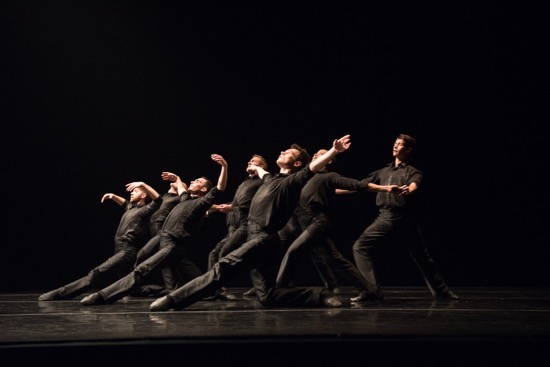
Barton Cowperthwaite (R) guiding the cast of Lar Lubovitch’s Men’s Stories. Photo: Nan Melville
The nine male dancers begin by making tableaux and encounters emerge from a swirl of unison. These can be gentlemanly or comradely—a bow here, boisterous athletic lift there. Traces of military correctness are visible. A duel seems about to emerge; a few men congregate at the back of the stage, apparently debating or exchanging information. Three of them throw imaginary dice for an outcome we’re not meant to discern, although it precedes a battle. These men can hurtle to the floor and arise the next second. Many times they leap, facing the audience, legs splitting in the air. They turn their arms into wreaths to create circles in the air as they travel. They’re expansive, indomitable.
I like the fact that their motives are mysterious although their actions are clear. That is, I don’t need to know why they’ve assembled or are doing what they’re doing; it seems enough to sense that they are a fraternity, alert to conflicts whether external or within the group. When Benjamin Holliday Wardell shoves others, I don’t wonder about the basis of his anger. Nor do I attempt to probe the provocative eccentricities that Jonathan Emanuell Alsberry shows us in a solo that ends with him being dragged offstage by two of his colleagues (the remarkable Alsberry has danced with Lubovitch’s company since 2007 and is now also its rehearsal director). Cowperthwaite, a commanding figure onstage, responds to the distortions in the score as if being punished by them, but the sex-education talk accompanies a duet for Colin Fuller and Perry that mirrors it in only one way: both involve two males.
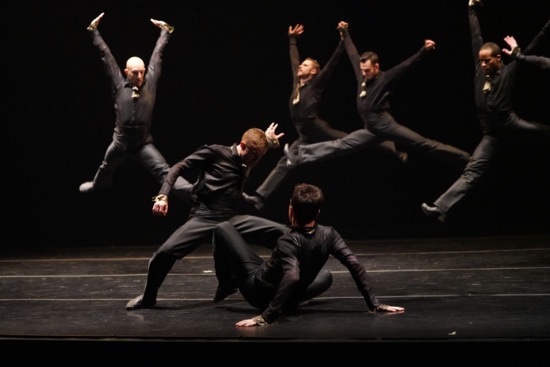
Contention in Lar Lubovitch’s Men’s Stories. In air (L to R):Benjamin Holliday Wardell, Lukasz Zięba, Reed Luplau, and Jonathan Emanuell Alsberry. Photo: Justin Chao
A fray develops. Eight of the men fight furiously within a loose cluster. As if he were their commanding officer, Cowperthwaite returns and breaks it up; they immediately and without protest calm down into presenting themselves as classical and at attention—erect, legs turned out, arms curved. Later, in semi-darkness, they remove their coats and vests and roll up their shirtsleeves. But not to contend. They return to movements they performed at the outset of Men’s Stories and continue forward in new ways. Part III of Beethoven’s score, slangily retitled “Schizo Scherzo,” sets them carousing. Along the way, certain other performers have moved into the foreground (not yet mentioned: Anthony Bocconi, and Reed Luplau ), but all (including Matthew McLaughlin and Lukasz Zięba) magnificently convey male brotherhood— its codes of another day and its timeless ramifications.
The piece ends with an ingenious surprise and tender joke. The men are resting, seated on the floor, when Alsberry reenters. With slim sticks, he’s manipulating the arms of a big-headed, knee-high puppet dressed just like the men; its feet are also connected to his. It wasn’t until I saw a 2013 revival of this work that I realized that the little figure was Beethoven. He went up to some of the men, shaking this one’s hand, caressing another’s cheek. I’m glad he approved.

Saw this show last night. You nailed it supremely.
joanf@harknessfoundation.org sent the following comment via e-mail. I gratefully reprint it here with her permission.
Now THIS is a review – THIS is real dance writing! What you have always understood, Deborah, is how to see and understand work on its own terms. This is richly rewarding for the viewer/writer and illuminating for the reader. Thank you!
Amen to Joan’s comment. I would only add that one of the things I have always liked the most about Lubovitch’s work is his choice of music. I would have loved to have seen the music and heard the dance in this performance–Deborah’s review as always put us in the theater with her, the next best thing to being there.
I have used your writings over the years as an example of the “best” kind of dance criticism. You brought me right into the theatre with this review of Lars’ work. Thank you.